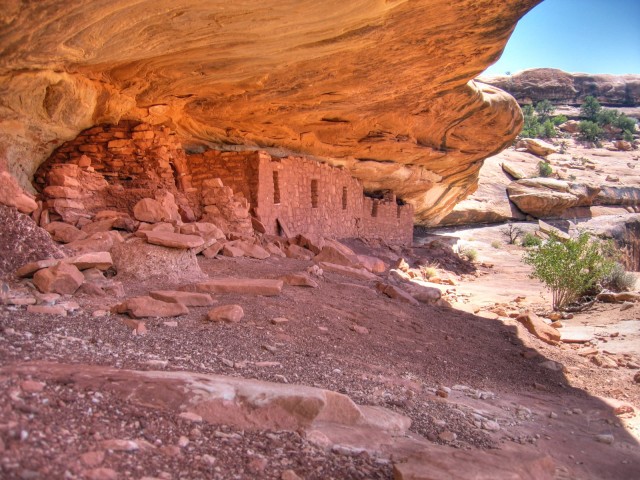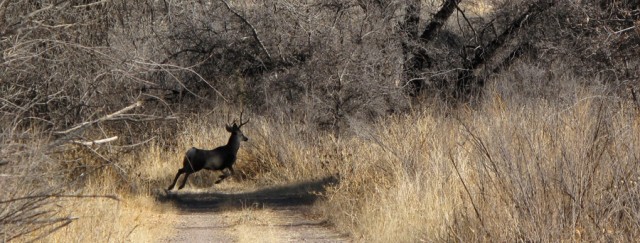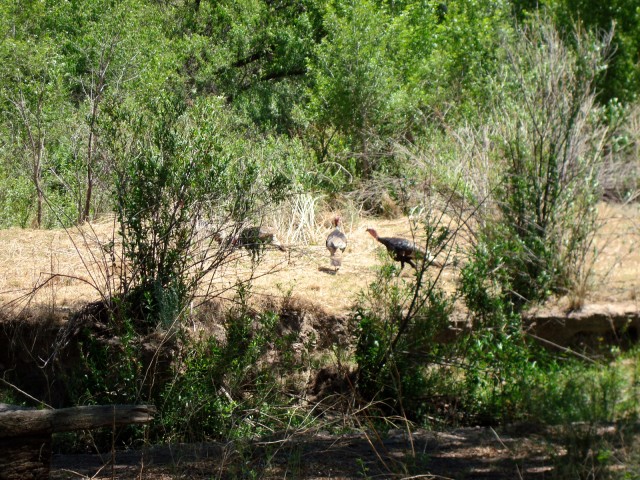- Home
- >
- Preservation Archaeology Blog
- >
- How Far Did They Carry Those Deer? And Where Did A...

April 28, 2015—I recently received the good news that a new project we’re starting here at Archaeology Southwest has been funded by the National Science Foundation (BCS-1460385). I’ll be working with Jeffrey Ferguson, an archaeological chemistry expert from the Archaeometry Laboratory at the University of Missouri Research Reactor, who has been a wonderful collaborator on various projects with Archaeology Southwest over the past few years.
Jeff and I will be studying the chemistry of animal bones from archaeological sites in the Mesa Verde area to examine how people’s access to food animals—especially deer and turkey—changed over time, specifically the period from A.D. 750–1280. This period saw tremendous changes in the way people lived:
- After A.D. 750, people built the first large (though short-lived) villages of 100 or more households
- This was followed by periods of fluctuation in the local human population, as waves of farmers left the area and then returned
- Starting in the 1100s, growing human populations packed ever-more-densely into villages
- And finally, after 1260, Pueblo farmers left the region entirely

These changes in the human population and in where and how farmers settled on the landscape are unusually well understood and have very precise dates attached to them, thanks to decades of research by archaeologists at Crow Canyon Archaeological Center and the Village Ecodynamics Project.
Such changes also had interesting consequences for the area’s plant and animal populations, which form the basis for our new research. We’re looking forward to working with the scientists of Crow Canyon and the Village Ecodynamics Project in our foray into the northern Southwest!
Before I began working here at Archaeology Southwest last year, I spent time as a postdoctoral research assistant to Jonathan Driver, an archaeologist at Simon Fraser University who has studied the animal bones in Crow Canyon’s collections for several decades. By combining the results of earlier analyses from many different sites, we were able to see some intriguing patterns in the animal bones, which represented hundreds of years of hunting by Ancestral Pueblo farmers.
Hunting and the landscape changes that accompany farming, gathering, and other human activities tend to create conditions that encourage some animal species and negatively affect others. In the assemblages we studied, large game (mostly deer and pronghorn) declined very quickly—within a generation of when people established the first large farming villages! Numbers of these animals’ bones in the sites continued to decline in virtually every group of bones for the rest of the time period we studied. In contrast, the number of turkey bones increased over time, suggesting domesticated turkey production may have grown, in part, to replace other meat sources.

The patterns Jon and I found raise several interesting questions. First, although declines in the number of large game animal bones in sites occurred quickly, people were still able to acquire these animals in smaller numbers throughout the following centuries. Where did they get them?
Hunters could find these animals within a few hours’ walk of their villages in early time periods, but then gradually had to walk farther and farther away to find them. Hunters who must carry carcasses home over long distances butcher them in various ways to discard heavy bones early on, but the bone assemblages here do not reveal the butchering patterns we’d normally associate with long-distance transport. Were the hunters carrying back bone as well as meat from these scarce animals? Or were small numbers of deer and pronghorn available near villages for centuries despite the constant hunting pressure?
Conservation biologists offer a potential explanation for the second scenario, which they have termed “source-sink dynamics,” in which animals are born in distant “source” areas where very few humans live permanently (such as mountainous areas too cold for growing corn). Some animals leave these source areas for the attractive landscapes around villages, with their tempting fields and gardens and almost no other large herbivores to compete with—in other words, the heavily hunted “sinks” where human hunters find them relatively easy prey.
Determining which of these scenarios were operating in the past means figuring out where the animals were coming from—a topic I’ll return to in a moment.
Another question is where all the turkeys came from. We think nearly all of these birds were domesticated, and earlier studies on a limited number of them showed that people almost entirely fed those birds corn. Raising enough corn to feed people and animals is a substantial investment of time and resources. Did every village make that investment, raising its own turkeys? Or did some villages trade for turkeys produced by others? How did those decisions change over time, particularly during drought periods when producing feed became more difficult, or during periods when relations between neighbors were less friendly?
Archaeological chemistry, specifically isotope analysis, will allow us to investigate 1) where the animals people ate were living before they were consumed, and 2) how this changed over time with fluctuations in human populations and human impacts on the landscape. Elements such as strontium occur naturally as several different isotopes, meaning forms with different numbers of neutrons in the nuclei of their atoms. These isotopes are found in different frequencies in different parts of the landscape due to variations in the composition and age of the local geology. Local variations in the ratios of these different isotopes are also transferred to the tissues of the plants that grow there and the animals that eat those plants.

Jeff Ferguson and I plan to sample plants and groundwater from eleven geologically distinct parts of the study area and analyze their chemical composition. We will then analyze the isotope ratios present in animal bones from local archaeological sites by sampling bones from existing museum collections. The results will allow us to link bones from older excavations in archaeological sites to the parts of the landscape they came from, giving us a new source of information on where humans hunted, where turkeys were raised, and how people acquired animals in the past.
In this region, deer are the most likely animals to have been transported long distances in the past. We will look for this pattern we by analyzing limb bones (tasty body parts carrying meat and marrow) and foot bones (one of the likeliest parts to be chopped off and left at a kill site by hunters far from home).
- Non-local isotope values in limb and foot bones would be consistent with deer born in distant source areas and moving into “sinks” near villages not long before being killed (or, perhaps, with long-distance transport of entire carcasses by hunters, a very costly choice in terms of energy returns).
- Non-local signatures in long bones and local signatures in foot bones would be consistent with a mix of long-distance hunting and some locally available deer.
- Local signatures in both elements would suggest hunters relied on remnant local deer populations at the edges of high-use hunting areas around their villages, and perhaps be a sign that deer populations were less depleted than previous studies have indicated.
Jeff and I will also analyze the strontium isotopes in turkey bones, which will give us similar insights into where people were raising turkeys in relation to the villages where people were consuming them. Examining carbon isotopes will also tell us how much corn these animals were eating, because corn’s photosynthesis process produces a different carbon isotope ratio than other plants turkeys would have eaten in this region in the past. Together, these ratios will tell us whether villagers raised their own turkeys for meat and how this changed over time as social connections between villages shifted.

One of the most exciting aspects of this new research is that, although it will help us better understand the past, it also has implications for the present. As human populations worldwide continue to grow and settle in formerly remote regions, questions about how to sustainably manage hunting are becoming increasingly urgent. In many areas, hunting must be maintained to provide long-term access to animals for local people (for whom access to these animals is important, nutritionally and culturally), yet hunting must also be managed to avoid loss of biodiversity and extirpations (local extinctions) of species.
Our study will apply data from a very long record of human hunting in an area where important animal resources experienced local declines but were never regionally extirpated, remaining accessible to hunters at some level for hundreds of years. If processes such as source-sink dynamics operated at a scale of centuries in the past, they should be promising options for local people to consider when deciding on tactics (such as quotas or game reserves) for managing hunting today in ways that allow continued access to important species without overusing them. I hope this work will allow us to take lessons from Preservation Archaeology to a larger preservation community involved in conservation biology and sustainable hunting and land use.
Check out Karen’s Archaeology Café on human-animal interactions in the past here (opens at our YouTube channel).
For more reading (must have subscriptions to read full articles; abstracts are presented at these links):
http://link.springer.com/article/10.1007%2Fs10816-012-9160-5
Schollmeyer, Karen Gust and Jonathan C. Driver
2013 Settlement Patterns, Source-Sink Dynamics, and Artiodactyl Hunting in the Prehistoric U.S. Southwest. Journal of Archaeological Method and Theory 20 (Special issue edited by V.L. Butler, C.M. Darwent, and M.J. O’Brien):448–487.
Varien, Mark D., Scott G. Ortman, Timothy A. Kohler, Donna M. Glowacki, and C. David Johnson
2007 Historical Ecology in the Mesa Verde Region: Results from the Village Ecodynamics Project. American Antiquity 72(2):273–299.
Explore the News
Related to This
-
Location Mesa Verde National Park